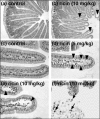Evidence for widespread epithelial damage and coincident production of monocyte chemotactic protein 1 in a murine model of intestinal ricin intoxication
- PMID: 17283086
- PMCID: PMC1865717
- DOI: 10.1128/IAI.01528-06
Evidence for widespread epithelial damage and coincident production of monocyte chemotactic protein 1 in a murine model of intestinal ricin intoxication
Abstract
The development of small-animal models is necessary to understand host responses and immunity to emerging infectious diseases and potential bioterrorism agents. In this report we have characterized a murine model of intestinal ricin intoxication. Ricin administered intragastrically (i.g.) to BALB/c mice at doses ranging from 1 to 10 mg/kg of body weight induced dose-dependent morphological changes in the proximal small intestine (i.e., duodenum), including widespread villus atrophy and epithelial damage. Coincident with epithelial damage was a localized increase in monocyte chemotactic protein 1, a chemokine known to be associated with inflammation of the intestinal mucosa. Immunity to intestinal ricin intoxication was achieved by immunizing mice i.g. with ricin toxoid and correlated with elevated levels of antitoxin mucosal immunoglobulin A (IgA) and serum IgG antibodies. We expect that this model will serve as a valuable tool in identifying the inflammatory pathways and protective immune responses that are elicited in the intestinal mucosa following ricin exposure and will prove useful in the evaluation of antitoxin vaccines and therapeutics.
Figures





Similar articles
-
Immunoglobulin A antibodies against ricin A and B subunits protect epithelial cells from ricin intoxication.Infect Immun. 2006 Jun;74(6):3455-62. doi: 10.1128/IAI.02088-05. Infect Immun. 2006. PMID: 16714576 Free PMC article.
-
Prophylactic and therapeutic efficacy of an avian antitoxin in ricin intoxication.Ther Immunol. 1995 Apr;2(2):59-66. Ther Immunol. 1995. PMID: 8729877
-
Vaccine-induced intestinal immunity to ricin toxin in the absence of secretory IgA.Vaccine. 2011 Jan 17;29(4):681-9. doi: 10.1016/j.vaccine.2010.11.030. Epub 2010 Nov 27. Vaccine. 2011. PMID: 21115050 Free PMC article.
-
Enhancement of intranasal vaccination in mice with deglycosylated chain A ricin by LTR72, a novel mucosal adjuvant.Vaccine. 2006 Mar 15;24(12):2213-21. doi: 10.1016/j.vaccine.2004.12.034. Epub 2005 Nov 15. Vaccine. 2006. PMID: 16325310
-
Treatments for Pulmonary Ricin Intoxication: Current Aspects and Future Prospects.Toxins (Basel). 2017 Oct 3;9(10):311. doi: 10.3390/toxins9100311. Toxins (Basel). 2017. PMID: 28972558 Free PMC article. Review.
Cited by
-
Distinct Metabolic States Are Observed in Hypoglycemia Induced in Mice by Ricin Toxin or by Fasting.Toxins (Basel). 2022 Nov 22;14(12):815. doi: 10.3390/toxins14120815. Toxins (Basel). 2022. PMID: 36548712 Free PMC article.
-
A neutralizing antibody to the a chain of abrin inhibits abrin toxicity both in vitro and in vivo.Clin Vaccine Immunol. 2008 May;15(5):737-43. doi: 10.1128/CVI.00254-07. Epub 2008 Mar 19. Clin Vaccine Immunol. 2008. PMID: 18353919 Free PMC article.
-
Acquisition of Chemoresistance and Other Malignancy-related Features of Colorectal Cancer Cells Are Incremented by Ribosome-inactivating Stress.J Biol Chem. 2016 May 6;291(19):10173-83. doi: 10.1074/jbc.M115.696609. Epub 2016 Mar 9. J Biol Chem. 2016. PMID: 26961878 Free PMC article.
-
Stress-responsive Gdf15 counteracts renointestinal toxicity via autophagic and microbiota reprogramming.Commun Biol. 2023 Jun 3;6(1):602. doi: 10.1038/s42003-023-04965-1. Commun Biol. 2023. PMID: 37270567 Free PMC article.
-
Mucosal vaccines for biodefense.Curr Top Microbiol Immunol. 2012;354:181-95. doi: 10.1007/82_2011_122. Curr Top Microbiol Immunol. 2012. PMID: 21461982 Free PMC article. Review.
References
-
- Anonymous. 2004. Summary of the NIAID Ricin Expert Panel Workshop. National Institutes of Health, Bethesda, MD.
-
- Atlas, R. M. 2003. Bioterrorism and biodefence research: changing the focus of microbiology. Nat. Rev. Microbiol. 1:70-74. - PubMed
-
- Audi, J., M. Belson, M. Patel, J. Schier, and J. Osterloh. 2005. Ricin poisoning: a comprehensive review. JAMA 294:2342-2351. - PubMed
-
- Baenziger, J. U., and D. Fiete. 1979. Structural determinants of Ricinus communis agglutinin and toxin specificity for oligosaccharides. J. Biol. Chem. 254:9795-9799. - PubMed
Publication types
MeSH terms
Substances
Grants and funding
LinkOut - more resources
Full Text Sources
Medical
Research Materials
Miscellaneous

